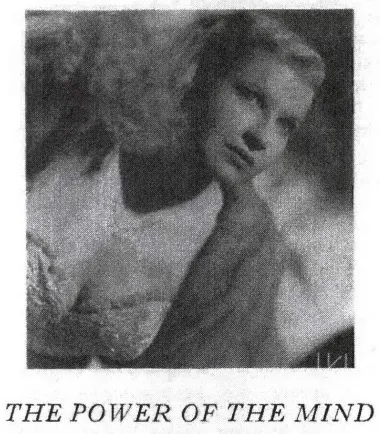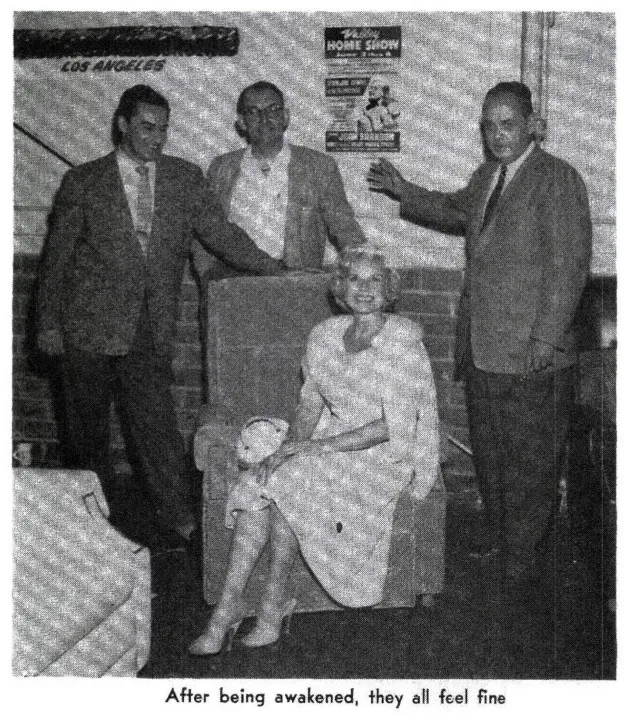
eBook - ePub
Science of Self-Hypnosis
Joan Brandon
This is a test
- 63 páginas
- English
- ePUB (apto para móviles)
- Disponible en iOS y Android
eBook - ePub
Science of Self-Hypnosis
Joan Brandon
Detalles del libro
Vista previa del libro
Índice
Citas
Información del libro
SELF HYPNOSIS is a natural endowment which may be developed for much good.Many of us take advantage of this power on numerous occasions without really realizing what we are doing.In the following chapters I shall endeavor to explain how these powers may be developed and how they may benefit you.YOU MAY WONDER, "Am I the self-hypnotic type? "Can I develop this control over my mind and body?"Yes, YOU CAN HYPNOTIZE YOURSELF. So long as you have the ability to concentrate, you can put to work latent energy, awaken new physical and mental powers that you never thought existed—but is takes practice and more practice!So, let's begin NOW!
Preguntas frecuentes
¿Cómo cancelo mi suscripción?
¿Cómo descargo los libros?
Por el momento, todos nuestros libros ePub adaptables a dispositivos móviles se pueden descargar a través de la aplicación. La mayor parte de nuestros PDF también se puede descargar y ya estamos trabajando para que el resto también sea descargable. Obtén más información aquí.
¿En qué se diferencian los planes de precios?
Ambos planes te permiten acceder por completo a la biblioteca y a todas las funciones de Perlego. Las únicas diferencias son el precio y el período de suscripción: con el plan anual ahorrarás en torno a un 30 % en comparación con 12 meses de un plan mensual.
¿Qué es Perlego?
Somos un servicio de suscripción de libros de texto en línea que te permite acceder a toda una biblioteca en línea por menos de lo que cuesta un libro al mes. Con más de un millón de libros sobre más de 1000 categorías, ¡tenemos todo lo que necesitas! Obtén más información aquí.
¿Perlego ofrece la función de texto a voz?
Busca el símbolo de lectura en voz alta en tu próximo libro para ver si puedes escucharlo. La herramienta de lectura en voz alta lee el texto en voz alta por ti, resaltando el texto a medida que se lee. Puedes pausarla, acelerarla y ralentizarla. Obtén más información aquí.
¿Es Science of Self-Hypnosis un PDF/ePUB en línea?
Sí, puedes acceder a Science of Self-Hypnosis de Joan Brandon en formato PDF o ePUB, así como a otros libros populares de Psicología y Historia y teoría en psicología. Tenemos más de un millón de libros disponibles en nuestro catálogo para que explores.
Información
Categoría
PsicologíaCategoría
Historia y teoría en psicología1.—The History Of Hypnotism
HYPNOTISM, comparatively speaking, is a new word although the science is as old as the human mind
In ancient times it was regarded as something of a mystical art. Today genuine hypnotism is a science such as physics and chemistry. We find the origin of the psychological point of view in the study of hypnosis.
One of the most famous figures in psychiatry, Anton Mesmer, further developed the ancient notion of the influence of the planets on the human body. Their influence was believed to be caused by a magnetic fluid, and it was the distribution of this fluid in the body that presumably determined health or disease. In attempting to find a cure for mental disorders, Mesmer came to the conclusion that all persons possessed magnetic forces which could be used to influence the distribution of the magnetic fluid in other persons, thus effecting cures.
Mesmer attempted to put his theory into practice in Vienna and in various other towns, but it was not until he came to Paris in 1778 that he achieved recognition. Here he opened a clinic in which he treated all kinds of diseases by “animal magnetism.” Mesmer was apparently able to remove certain anaesthesias and paralyses and to produce many of the phenomena discovered by later hypnotists.
Finally branded as a charlatan by his medical colleagues, Mesmer was forced to leave Paris and shortly faded into obscurity. However, his methods were the center of controversy in scientific circles for many years.
James Braid, in England, concluded that the removal of these anaesthesias and paralyses which had been ascribed to the action of magnetism were actually due to the suggestive effect of ideas aroused in the patients’ minds. Braid referred to these effects of suggestion as “hypnotism.” Investigations in this line lagged after the time of Braid, but during the latter part of the nineteenth century, hypnosis was used by some physicians in their medical practices.
One of the most successful of these physicians was the Frenchman Liebault who practiced at Nancy. Also in Nancy at this time was a professor of medicine, Bernheim, who became interested in hypnosis primarily as a result of Liebault’s successful cure by hypnosis of a patient whom Bernheim had been unsuccessfully treating by more conventional methods for several years. The physicians who accepted their views were known as the “Nancy School.”
Charcot, who was the head of the Salpêtrière Hospital in Paris and the leading neurologist of his time, had been experimentally investigating some of the phenomena described by the old “Mesmerists.” As a result of his research, Charcot disagreed with the findings of Bernheim and Liebault.
In one of the major medical debates of history, in which many harsh words were used on both sides, the viewpoint of the Nancy School in Nancy, France, triumphed and Charcot’s opinions were proven erroneous Eventually Charcot himself, a man of great scientific honesty, was won over to the new point of view and did much to project these concepts into the practice of medicine.
Sigmund Freud, a brilliant young Viennese physician, went to Paris in 1885 to study under Charcot and later became acquainted with the work of Liebault and Bernheim at Nancy. He was greatly impressed by their use of hypnosis and came away convinced that powerful mental processes may remain hidden from consciousness.
On his return to Vienna, Freud worked in collaboration with an older physician, Joseph Breuer, who had introduced an interesting innovation in the use of hypnosis on his neurotic patients. He let the patient under hypnosis talk about her problems and tell what had oppressed her. The patient usually talked rather freely under these circumstances, and on awakening from the hypnotic state felt considerably relieved. This simple innovation in the use of hypnosis proved to be of great significance, for not only did it help the patient to discharge her emotional tensions by discussion of her problems, but it revealed the nature of the difficulties which had brought about her neurotic symptoms. The patient saw no relationship between her problems and her symptoms but the therapist could usually see it quite readily. Thus was made the discovery of the “unconscious.”

THE POWER of the mind exceeds our imagination. You are stronger and more powerful than you think you are, both physically and mentally. You may learn to utilize this phenomenal power by concentration, and auto-suggestion.
2.—Your Questions and the Answers
What is hypnotism?
It is a science of human behavior based on well-established principles of psychology and physiology.
The theory and practice of inducing hypnosis or hypnotic sleep.
It is a state resembling sleep or somnambulism which, is induced by concentration and suggestion.
*****
What is hypnosis?
The hypnotic state or condition.
A state of mind.
An artificial trance sleep.
*****
What is self-hypnosis?
It is a self-induced hypnotic state and has the characteristics of the hypnotic state induced by a hypnotist.
What is somnambulism?
This is the act or state of walking and performing other actions during sleep.
*****
Can a person talk while he is hypnotized?
Yes. That is known as somniloquy which means the act of talking when asleep, especially in hypnotic sleep.
*****
What is auto-suggestion?
Merely suggestion, particularly with a view to produce a condition of auto-hypnosis, emanating from self only. It requires the ability to concentrate strongly so as to impress thoughts upon the unconscious mind.
*****
What is meant by post-hypnotic suggestion?
A suggestion is impressed firmly upon the mind of a hypnotized person He will perform the suggested action after being awakened. However, if the action suggested is against his morals, conscience, or definite wishes he may refrain It is interesting in this connection that there is no crime on record which has been performed by a person under the influence of hypnosis and against his own will.
*****
During my presentations I always include post-hypnotic demonstrations and even go a step further by showing how a person will respond to suggestions which are given after he is awakened. Needless to say my suggestions never conflict with a person’s conscience.
The phenomenon of hypnosis is fascinating and each person reacts differently. I have hypnotized thousands of persons and have never had one complaint about the sensation. In fact, they all seem to enjoy it. After I awaken them they tell me that they feel rested and relaxed.
I have found that the more intelligent a person is, the better subject for hypnotism he will be.

3.—A Phenomenon of Hypnosis
AS THE PUBLIC becomes more enlightened they seem to become more and more fascinated.
On numerous occasions before various groups of doctors I have scientifically demonstrated how a blister may be formed on a person’s arm by suggestion.
I tell the hypnotized person, whom we call the subject, that he or she will be touched on the forearm with a red-hot iron and that a blister will form.
Then I touch the forearm with a borrowed pencil. The subject reacts as though actually being burned and a blister forms.
What is this strange power that can perform such a feat of magic?
The power of suggestion!
A person under hypnosis is extremely susceptible to suggestion from the hypnotist.
The suggestions which I give are, with very few exceptions, accept...
Índice
- Title page
- TABLE OF CONTENS
- YOU CAN
- AUTHOR’S NOTE
- PREFACE
- 1.-The History Of Hypnotism
- 2.-Your Questions and the Answers
- 3.-A Phenomenon of Hypnosis
- 4.-Wake Up At Will
- 5.-The Technique of Self-Hypnosis
- 6.-Auto-Suggestion
- 7.-Are You An Insomniac?
- 8.-Hypnotism-Physiological And Psychological
- 9.-How to Alleviate Pain
- 10.-Dental Patients Feel No Pain
- 11.-Hypnosis And Childbirth
- 12.-Success and Self-Confidence
- 13.-Public Speaking Without Stage Fright
- 14.-Reducing or Gaining Weight
- 15.-Help Requested
- 16.-You, too, Can be Happy
- 17.-How to Rid Yourself and Your Children of Bad Habits
- 18.-Learning The Easy Way
- 19.-Hypnotism
- 20.-Subliminal Projection
- REQUEST FROM THE PUBLISHER
Estilos de citas para Science of Self-Hypnosis
APA 6 Citation
Brandon, J. (2018). Science of Self-Hypnosis ([edition unavailable]). Muriwai Books. Retrieved from https://www.perlego.com/book/971129/science-of-selfhypnosis-pdf (Original work published 2018)
Chicago Citation
Brandon, Joan. (2018) 2018. Science of Self-Hypnosis. [Edition unavailable]. Muriwai Books. https://www.perlego.com/book/971129/science-of-selfhypnosis-pdf.
Harvard Citation
Brandon, J. (2018) Science of Self-Hypnosis. [edition unavailable]. Muriwai Books. Available at: https://www.perlego.com/book/971129/science-of-selfhypnosis-pdf (Accessed: 14 October 2022).
MLA 7 Citation
Brandon, Joan. Science of Self-Hypnosis. [edition unavailable]. Muriwai Books, 2018. Web. 14 Oct. 2022.